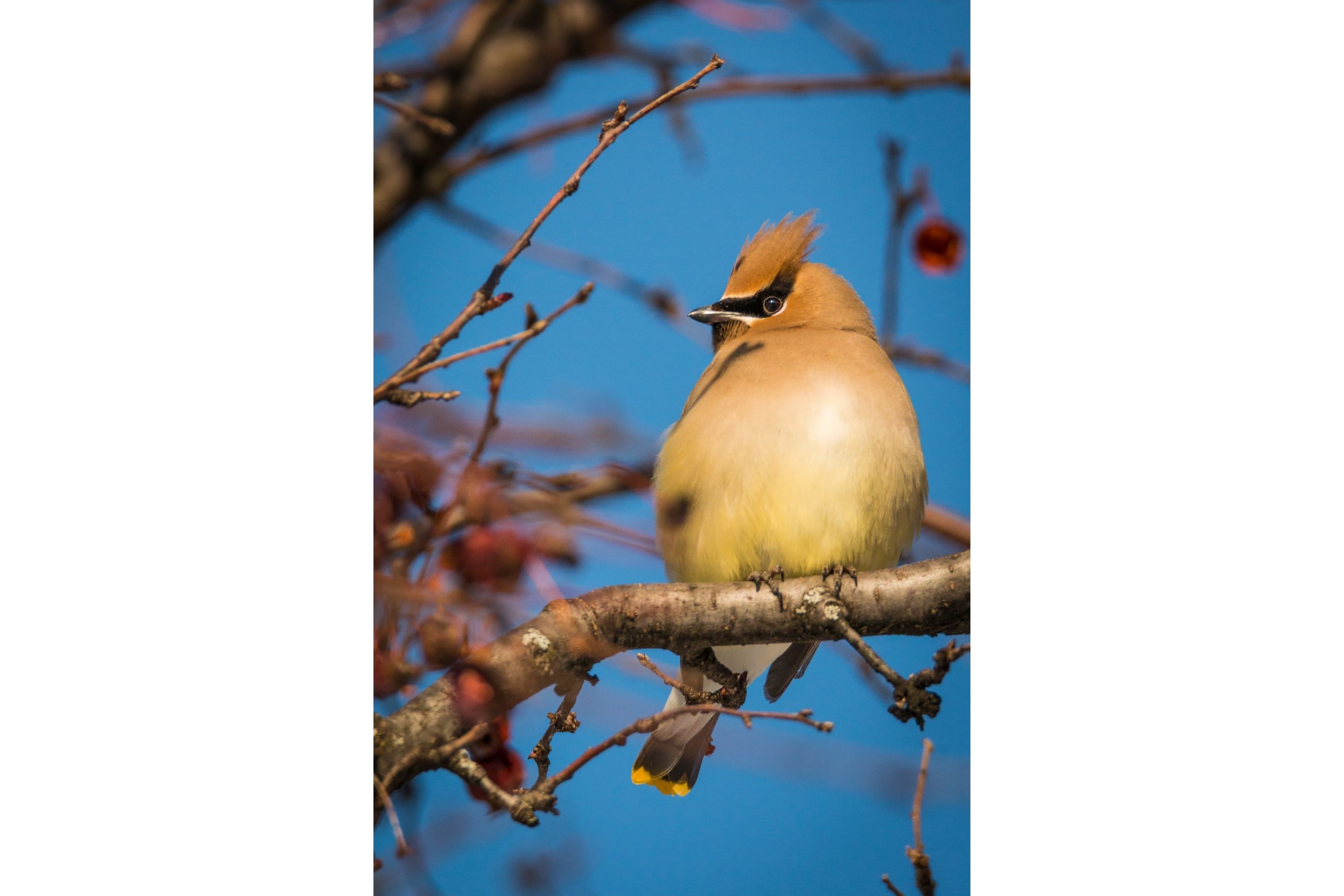Cedar Waxwing
(Bombycilla cedrorum)

Description
Bombycilla cedrorum, commonly known as the Cedar Waxwing, is a beautiful and fascinating bird that inhabits a wide range of North America. This species is known for its sleek plumage, unique coloration, and distinctive crested head, making it a popular subject for birdwatchers and nature enthusiasts alike. In this article, we will explore the physical characteristics, behavior, habitat, and conservation status of this remarkable bird species. Physical Characteristics The Cedar Waxwing is a medium-sized bird, measuring around 6-7 inches in length and weighing between 1-1.5 ounces. They have a unique and striking appearance, with a soft, silky plumage that is primarily grayish-brown. Their wings are highlighted by bright red wax-like tips on the secondary feathers, while their tail feathers are tipped in bright yellow. One of the most distinguishing features of the Cedar Waxwing is its crested head, which features a small, forward-facing crest that gives the bird a distinctive silhouette. Their black mask-like feathers around the eyes give them a distinctive, almost bandit-like appearance, while the bright yellow patch on their belly adds a splash of color to their otherwise subdued plumage. Habitat and Range Bombycilla cedrorum is a widespread bird species that can be found throughout North America. Their range extends from southern Canada to the northernmost regions of Central America. Cedar Waxwings are adaptable birds that can inhabit a wide range of habitats, including forests, woodlands, orchards, and suburban areas. They are particularly fond of fruiting trees and shrubs, such as cedar, juniper, and holly trees, as well as mountain ash, chokecherry, and other berry-producing shrubs. Cedar Waxwings can be found in a variety of elevations, from lowlands to mountainous regions. They are known to move to different locations in response to food availability, and they may undertake seasonal migrations to follow fruiting patterns. Overall, Cedar Waxwings have a broad range and can be found in a diverse range of habitats, as long as there are suitable fruiting trees and shrubs available for them to feed on. Behavior Cedar Waxwing is known for its unique social behavior. These birds are highly gregarious and tend to travel and feed in large flocks, often numbering in the hundreds or even thousands. Cedar Waxwings have a particular affinity for fruit, especially berries, and will often fly long distances to seek out fruiting trees and bushes. They are known to spend hours gorging on sweet, juicy treats. This behavior has earned them the nickname "Bohemian Waxwing" due to their seemingly hedonistic and free-spirited lifestyle. Cedar Waxwings also have a unique courtship behavior where they pass small objects, such as berries or flower petals, back and forth between mates as a part of their bonding process. Overall, Cedar Waxwings are active and sociable birds, often found foraging and flying in groups. They have a distinct and fascinating behavior that makes them a popular subject among birdwatchers and nature enthusiasts. Diet Bombycilla cedrorum has a primarily frugivorous diet, which means they primarily feed on fruits. They have a particular affinity for soft, fleshy fruits, especially berries. Some of their preferred berry sources include cedar berries, juniper berries, serviceberries, hawthorn berries, and mountain ash berries. Cedar Waxwings also occasionally eat insects, especially during the breeding season when they need to provide protein for their young. Insects they may feed on include beetles, caterpillars, and flies. They catch insects while in flight or by gleaning them from leaves or branches. Cedar Waxwings are also known to occasionally eat sap, buds, and flowers, particularly in the absence of ripe fruit. Overall, Cedar Waxwings have a specialized diet that is primarily focused on fruits, making them an important seed disperser for many plant species. Breeding Cedar Waxwing has a unique breeding behavior. They form monogamous pairs during the breeding season and engage in a variety of courtship behaviors, such as mutual preening and the exchange of small objects like berries or flower petals. The breeding season of Cedar Waxwings generally begins in late spring and extends through early summer. The female builds a shallow cup-shaped nest, usually in a tree or shrub, using twigs, grasses, and other plant material, and lines it with finer materials like moss or animal hair. The female typically lays between 2-6 eggs, which are pale blue with black or brown spots. Both parents take turns incubating the eggs for a period of 12-14 days. Once the eggs hatch, the chicks are altricial, meaning they are born helpless and require a lot of parental care. Both parents participate in feeding and caring for the chicks, bringing them a variety of foods, including fruit and insects. The chicks fledge from the nest after about 14-18 days and become independent a few weeks later. Cedar Waxwings may have up to two broods per breeding season, with the second brood typically being smaller than the first. Overall, Cedar Waxwings have a unique and fascinating breeding behavior, which involves monogamous pair formation, elaborate courtship rituals, and shared parental care. Conservation Status Despite their wide range and adaptability, Cedar Waxwings face a number of threats that could impact their long-term survival. Habitat loss and fragmentation, caused by urbanization, logging, and other human activities, is one of the most significant threats to their populations. Additionally, Cedar Waxwings are highly susceptible to pesticides and other chemical contaminants, which can accumulate in their bodies and cause reproductive failure, weakened immune systems, and other health problems. Climate change is also expected to have a significant impact on Cedar Waxwing populations, as it could alter the timing of fruiting events and disrupt the birds' migratory patterns. To help protect Cedar Waxwings and other bird species, it is important to support conservation efforts aimed at preserving their habitats, reducing pesticide use, and promoting sustainable land use practices. By working together, we can help ensure that these beautiful and fascinating birds continue to thrive for generations to come.
Taxonomic tree:







